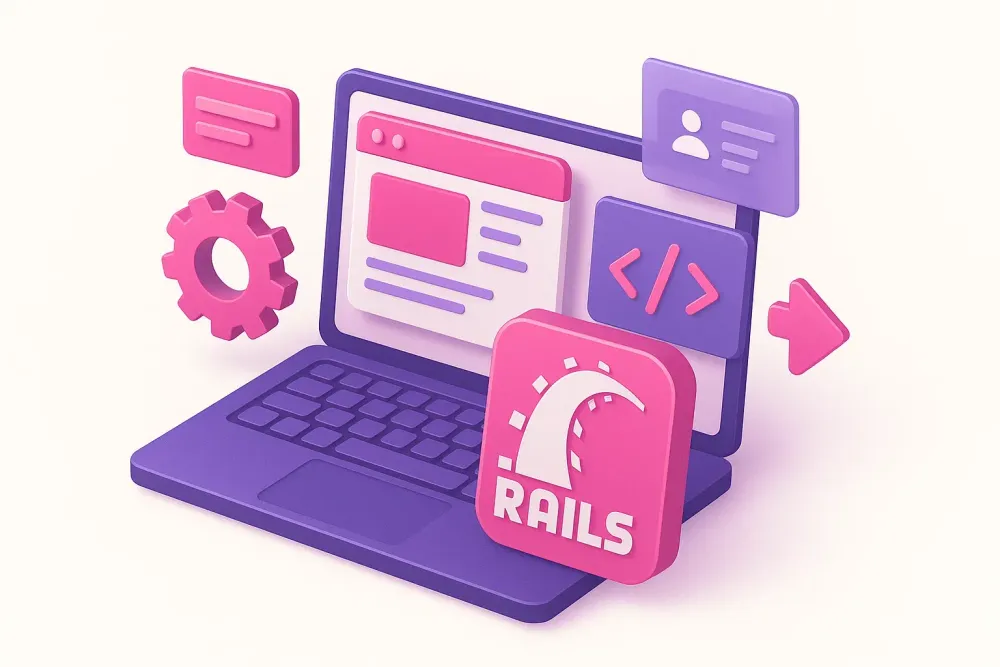Home
Services
Products
Projects
Who We Are
Blogs
Contact Us

Streamline Web Development with Ruby on Rails: The Ultimate Framework
Ruby on Rails, an open-source framework, simplifies web application development, deployment, and maintenance. Built using the Ruby programming language, Rails was created by David Heinemeier Hansson in 2005 and has continuously evolved through ongoing updates.
Driven by a desire for modern and professional development practices, developers embraced Rails, discovering it to be much more than a simple tool for building websites. It has transformed into a dynamic, fully functional ecosystem—becoming a primary choice for a diverse community of developers.
A Powerful MVC Framework
Rails applications are structured around the Model-View-Controller (MVC) architecture—taken to the next level. From the outset, development begins with a working application skeleton. This framework provides a designated place for every piece of code, ensuring that all components interact seamlessly within a standardized setup.
Rails identifies the central themes of your application and embeds them within a reusable, common codebase. In essence, starting a Rails project means you're already halfway to a finished product.
Powered by Ruby
Written in the Ruby programming language, Rails inherits Ruby's elegant design and multi-paradigm support. Ruby is a purely object-oriented language designed for expressive and natural coding. It’s widely used not only in web development but also in:
- Task automation
- Game programming
- System administration
Ruby's concise syntax allows complex ideas to be expressed succinctly, resulting in shorter, more readable programs. It also eliminates the need for extensive external configuration files, allowing tasks to be handled directly in the codebase.
Core Principles: DRY and Convention Over Configuration
Rails adheres to the DRY (Don't Repeat Yourself) principle—every piece of logic should exist in a single place. This reduces redundancy, which in turn minimizes the impact of changes across the codebase. Because Rails is written in Ruby, changes are localized and easier to manage.
Another guiding principle is Convention over Configuration. Rails provides sensible defaults for almost every aspect of app development. Developers can build robust applications faster with less boilerplate code—without sacrificing flexibility, as these conventions can be overridden when necessary.
Standout Features of Ruby on Rails
- Built-in support for Ajax and RESTful interfaces
- Streamlined deployment to multiple servers using a single command
- Simple development process without heavy IDEs or complex toolchains
- Integrated documentation via RDoc, making it easy to document as you code
- Rapid prototyping and early delivery, allowing faster client feedback and requirement refinement
These features help teams develop production-ready applications efficiently, with fewer delays and smoother collaboration between developers, stakeholders, and end-users.
Conclusion
Ruby on Rails remains a compelling choice for modern web development. Its focus on simplicity, convention, and developer productivity makes it ideal for startups and enterprises alike. Whether you're building an MVP or scaling a mature application, Rails provides the structure and flexibility needed to succeed.
At DEFX, our experienced Ruby on Rails experts are ready to help you streamline your web development process. From rapid prototyping to full-scale deployment, Defx offers tailored solutions that align with your business goals.
Get in touch with DEFX today to discover how we can bring your Ruby on Rails project to life with speed, quality, and precision.
See More
Contact Us
Let’s make your Idea into Reality
Let's Talk
© Copyright DEFX. All Rights Reserved
GoodFirms ★ 4.2
Clutch ★ 4.2
Google ★ 4.2
